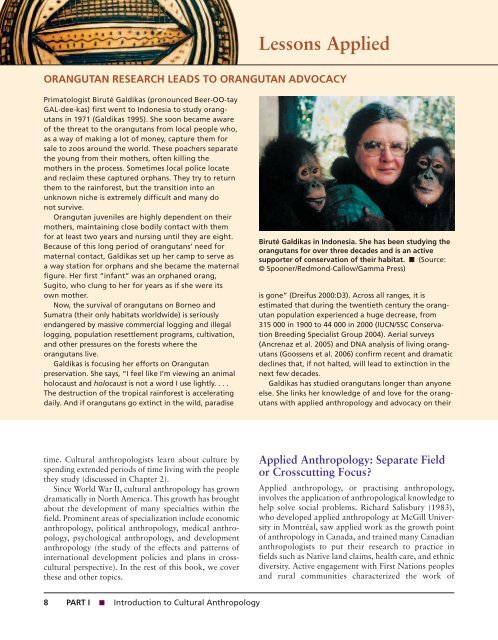PART Introduction to Cultural Anthropology - Pearson Canada
PART Introduction to Cultural Anthropology - Pearson Canada
PART Introduction to Cultural Anthropology - Pearson Canada
You also want an ePaper? Increase the reach of your titles
YUMPU automatically turns print PDFs into web optimized ePapers that Google loves.
Lessons Applied<br />
ORANGUTAN RESEARCH LEADS TO ORANGUTAN ADVOCACY<br />
Prima<strong>to</strong>logist Biruté Galdikas (pronounced Beer-OO-tay<br />
GAL-dee-kas) first went <strong>to</strong> Indonesia <strong>to</strong> study orangutans<br />
in 1971 (Galdikas 1995). She soon became aware<br />
of the threat <strong>to</strong> the orangutans from local people who,<br />
as a way of making a lot of money, capture them for<br />
sale <strong>to</strong> zoos around the world. These poachers separate<br />
the young from their mothers, often killing the<br />
mothers in the process. Sometimes local police locate<br />
and reclaim these captured orphans. They try <strong>to</strong> return<br />
them <strong>to</strong> the rainforest, but the transition in<strong>to</strong> an<br />
unknown niche is extremely difficult and many do<br />
not survive.<br />
Orangutan juveniles are highly dependent on their<br />
mothers, maintaining close bodily contact with them<br />
for at least two years and nursing until they are eight.<br />
Because of this long period of orangutans’ need for<br />
maternal contact, Galdikas set up her camp <strong>to</strong> serve as<br />
a way station for orphans and she became the maternal<br />
figure. Her first “infant” was an orphaned orang,<br />
Sugi<strong>to</strong>, who clung <strong>to</strong> her for years as if she were its<br />
own mother.<br />
Now, the survival of orangutans on Borneo and<br />
Sumatra (their only habitats worldwide) is seriously<br />
endangered by massive commercial logging and illegal<br />
logging, population resettlement programs, cultivation,<br />
and other pressures on the forests where the<br />
orangutans live.<br />
Galdikas is focusing her efforts on Orangutan<br />
preservation. She says, “I feel like I’m viewing an animal<br />
holocaust and holocaust is not a word I use lightly....<br />
The destruction of the tropical rainforest is accelerating<br />
daily. And if orangutans go extinct in the wild, paradise<br />
Biruté Galdikas in Indonesia. She has been studying the<br />
orangutans for over three decades and is an active<br />
supporter of conservation of their habitat. ■ (Source:<br />
© Spooner/Redmond-Callow/Gamma Press)<br />
is gone” (Dreifus 2000:D3). Across all ranges, it is<br />
estimated that during the twentieth century the orangutan<br />
population experienced a huge decrease, from<br />
315 000 in 1900 <strong>to</strong> 44 000 in 2000 (IUCN/SSC Conservation<br />
Breeding Specialist Group 2004). Aerial surveys<br />
(Ancrenaz et al. 2005) and DNA analysis of living orangutans<br />
(Goossens et al. 2006) confirm recent and dramatic<br />
declines that, if not halted, will lead <strong>to</strong> extinction in the<br />
next few decades.<br />
Galdikas has studied orangutans longer than anyone<br />
else. She links her knowledge of and love for the orangutans<br />
with applied anthropology and advocacy on their<br />
time. <strong>Cultural</strong> anthropologists learn about culture by<br />
spending extended periods of time living with the people<br />
they study (discussed in Chapter 2).<br />
Since World War II, cultural anthropology has grown<br />
dramatically in North America. This growth has brought<br />
about the development of many specialties within the<br />
field. Prominent areas of specialization include economic<br />
anthropology, political anthropology, medical anthropology,<br />
psychological anthropology, and development<br />
anthropology (the study of the effects and patterns of<br />
international development policies and plans in crosscultural<br />
perspective). In the rest of this book, we cover<br />
these and other <strong>to</strong>pics.<br />
Applied <strong>Anthropology</strong>: Separate Field<br />
or Crosscutting Focus?<br />
Applied anthropology, or practising anthropology,<br />
involves the application of anthropological knowledge <strong>to</strong><br />
help solve social problems. Richard Salisbury (1983),<br />
who developed applied anthropology at McGill University<br />
in Montréal, saw applied work as the growth point<br />
of anthropology in <strong>Canada</strong>, and trained many Canadian<br />
anthropologists <strong>to</strong> put their research <strong>to</strong> practice in<br />
fields such as Native land claims, health care, and ethnic<br />
diversity. Active engagement with First Nations peoples<br />
and rural communities characterized the work of<br />
8 <strong>PART</strong> I ■ <strong>Introduction</strong> <strong>to</strong> <strong>Cultural</strong> <strong>Anthropology</strong>
















